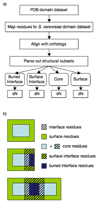Structural mapping of protein interactions reveals differences in evolutionary pressures correlated to mRNA level and protein abundance
- PMID: 17997970
- PMCID: PMC2600897
- DOI: 10.1016/j.str.2007.09.010
Structural mapping of protein interactions reveals differences in evolutionary pressures correlated to mRNA level and protein abundance
Abstract
Genome-wide studies in Saccharomyces cerevisiae concluded that the dominant determinant of protein evolutionary rates is expression level: highly expressed proteins generally evolve most slowly. To determine how this constraint affects the evolution of protein interactions, we directly measure evolutionary rates of protein interface, surface, and core residues by structurally mapping domain interactions to yeast genomes. We find that mRNA level and protein abundance, though correlated, report on pressures affecting regions of proteins differently. Pressures proportional to mRNA level slow evolutionary rates of all structural regions and reduce the variability in rate differences between interfaces and other surfaces. In contrast, the evolutionary rate variation within a domain is much less correlated to protein abundance. Distinct pressures may be associated primarily with the cost (mRNA level) and functional (protein abundance) benefit of protein production. Interfaces of proteins with low mRNA levels may have higher evolutionary flexibility and could constitute the raw material for new functions.
Figures







Similar articles
-
Structure-guided Evolutionary Analysis of Interactome Network Rewiring at Single Residue Resolution in Yeasts.J Mol Biol. 2024 Aug 15;436(16):168641. doi: 10.1016/j.jmb.2024.168641. Epub 2024 Jun 4. J Mol Biol. 2024. PMID: 38844045
-
The causes of protein evolutionary rate variation.Trends Ecol Evol. 2006 May;21(5):230-2. doi: 10.1016/j.tree.2006.03.008. Epub 2006 Mar 24. Trends Ecol Evol. 2006. PMID: 16697908
-
Evolutionary constraints on yeast protein size.BMC Evol Biol. 2006 Aug 15;6:61. doi: 10.1186/1471-2148-6-61. BMC Evol Biol. 2006. PMID: 16911784 Free PMC article.
-
The Saccharomyces cerevisiae poly (A) binding protein (Pab1): Master regulator of mRNA metabolism and cell physiology.Yeast. 2019 Jan;36(1):23-34. doi: 10.1002/yea.3347. Epub 2018 Oct 17. Yeast. 2019. PMID: 30006991 Review.
-
Protein phosphatases of Saccharomyces cerevisiae.Curr Genet. 2019 Feb;65(1):41-55. doi: 10.1007/s00294-018-0884-y. Epub 2018 Sep 17. Curr Genet. 2019. PMID: 30225534 Free PMC article. Review.
Cited by
-
Detecting clusters of mutations.PLoS One. 2008;3(11):e3765. doi: 10.1371/journal.pone.0003765. Epub 2008 Nov 19. PLoS One. 2008. PMID: 19018282 Free PMC article.
-
Global signatures of protein and mRNA expression levels.Mol Biosyst. 2009 Dec;5(12):1512-26. doi: 10.1039/b908315d. Epub 2009 Oct 1. Mol Biosyst. 2009. PMID: 20023718 Free PMC article. Review.
-
InterEvol database: exploring the structure and evolution of protein complex interfaces.Nucleic Acids Res. 2012 Jan;40(Database issue):D847-56. doi: 10.1093/nar/gkr845. Epub 2011 Nov 3. Nucleic Acids Res. 2012. PMID: 22053089 Free PMC article.
-
Loss of quaternary structure is associated with rapid sequence divergence in the OSBS family.Proc Natl Acad Sci U S A. 2014 Jun 10;111(23):8535-40. doi: 10.1073/pnas.1318703111. Epub 2014 May 28. Proc Natl Acad Sci U S A. 2014. PMID: 24872444 Free PMC article.
-
Signatures of protein biophysics in coding sequence evolution.Curr Opin Struct Biol. 2010 Jun;20(3):385-9. doi: 10.1016/j.sbi.2010.03.004. Epub 2010 Apr 13. Curr Opin Struct Biol. 2010. PMID: 20395125 Free PMC article. Review.
References
-
- Aloy P, Ceulemans H, Stark A, Russell RB. The relationship between sequence and interaction divergence in proteins. Journal of molecular biology. 2003;332:989–998. - PubMed
-
- Altschul SF, Gish W, Miller W, Myers EW, Lipman DJ. Basic local alignment search tool. Journal of molecular biology. 1990;215:403–410. - PubMed
Publication types
MeSH terms
Substances
Grants and funding
LinkOut - more resources
Full Text Sources
Molecular Biology Databases

